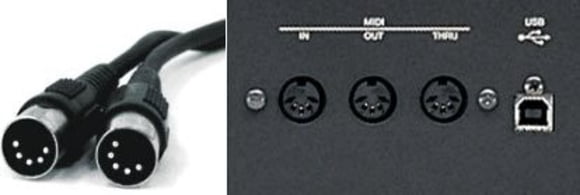3. MIDI Explained
Musical Instrument Digital Interface (MIDI) is a method of communication between electronic instruments that adhere to the standard, and also with computers via a MIDI interface. MIDI messages contain information about such things as which notes are to be sounded, when, how loudly and for how long, as well as the type of sound that is to be produced, and general control and timing information. To pass these messages between MIDI devices, specially wired MIDI leads are used to connect together each instrument or computers MIDI interface. There are generally three connectors In, Out and Thru - and all use a 5-pin DIN socket.
- MIDI In this connector receives MIDI signals from other devices.
- MIDI Out this connector sends MIDI signals to other devices.
- MIDI Thru - this connector provides a relay of the MIDI signals received at the MIDI In port so that a number of MIDI devices can be chained together.
Unlike an audio lead that passes sound from an instrument to a mixer or speaker, MIDI leads pass MIDI messages used to represent music. Try thinking of MIDI messages as instructions such as start playing middle C, stop playing A3, or select your piano sound. Each of these instructions can be sent via up to 16 independent MIDI channels down a single MIDI cable, allowing sets of instruments (e.g. drums, bass, piano etc) to be played simultaneously. MIDI can also carry other metadata such as the instrument names for each channel, the key signature, lyrics and copyright information.
The upshot of all this is that by representing music as MIDI information, it can be easily edited, adjusted, and played back on different sounds, or even on entirely different instruments, all of which will come into its own once we start to discuss the auto-accompaniment and song writing facilities of portable keyboards.


